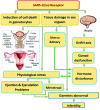A review on human reproductive systems encountering with the severe acute respiratory syndrome coronavirus 2 infection
- PMID: 36875501
- PMCID: PMC9982318
- DOI: 10.18502/ijrm.v21i1.12661
A review on human reproductive systems encountering with the severe acute respiratory syndrome coronavirus 2 infection
Abstract
The severe acute respiratory syndrome coronavirus 2 (SARS-CoV2) is the leading cause of the new deadly pneumonia named coronavirus disease 2019 (COVID-19) pandemic. This pathogen has different co-receptors on various tissues, resulting in vast pathophysiological circumstances. Here, we present a comprehensive narrative review focusing on the impact of SARS-CoV2 on human reproduction. Evidence-based literature revealed inconsistent results for this virus in the reproductive organs of patients with COVID-19, even in the critical phase. Conversely, numerous satisfactory data represented those different reproductive activities, from gametogenesis to pregnancy, can be targeted by SARS-CoV2. The severity of COVID-19 depends on the differential expression of the host cellular components required to enter SARS-CoV2. The cytokine storm and oxidative stress coming out during COVID-19 are associated with complications in reproductive endocrinopathies. Men are naturally more susceptible to COVID-19, especially accompanied by orchitis and varicocele. Synergistically the interaction of SARS-CoV2 and female reproductive failures (polycystic ovary syndrome and endometriosis) increases the susceptibility to COVID-19. Thus, pharmaceutical interventions that ameliorate the complications in individuals with reproductive disorders can be helpful to achieve good outcomes in assisted reproductive techniques. Soon, an increase in the infertility rate will likely be an overall impact of SARS-CoV2 in patients who recovered from COVID-19.
Keywords: Human; Reproductive system.; SARS-CoV-2.
Copyright © 2023 Samadian et al.
Conflict of interest statement
The authors do not have any affiliation beside any organization as an indirect or direct financial contribution the subject matter mentioned in the manuscript. All authors have taken part in (1) conception design and conception, or analysis and elucidation of the data; (2) article drafting or revising it in critical manner for significant intellectual content; also (3) approval of the last version. We have not submitted this manuscript yet, furthermore it is not under review with another journal or publishing venue.
Figures



Similar articles
-
Prior and novel coronaviruses, Coronavirus Disease 2019 (COVID-19), and human reproduction: what is known?Fertil Steril. 2020 Jun;113(6):1140-1149. doi: 10.1016/j.fertnstert.2020.04.025. Epub 2020 Apr 16. Fertil Steril. 2020. PMID: 32482250 Free PMC article.
-
Surviving the Rookie Virus, Severe Acute Respiratory Syndrome Coronavirus 2 (SARS-CoV2): The Immunopathology of a SARS-CoV2 Infection.Cell Transplant. 2021 Jan-Dec;30:963689721993769. doi: 10.1177/0963689721993769. Cell Transplant. 2021. PMID: 33840257 Free PMC article. Review.
-
COVID-19 and multiorgan failure: A narrative review on potential mechanisms.J Mol Histol. 2020 Dec;51(6):613-628. doi: 10.1007/s10735-020-09915-3. Epub 2020 Oct 4. J Mol Histol. 2020. PMID: 33011887 Free PMC article. Review.
-
Testing the efficacy and safety of BIO101, for the prevention of respiratory deterioration, in patients with COVID-19 pneumonia (COVA study): a structured summary of a study protocol for a randomised controlled trial.Trials. 2021 Jan 11;22(1):42. doi: 10.1186/s13063-020-04998-5. Trials. 2021. PMID: 33430924 Free PMC article.
-
Host Response to SARS-CoV2 and Emerging Variants in Pre-Existing Liver and Gastrointestinal Diseases.Front Cell Infect Microbiol. 2021 Oct 25;11:753249. doi: 10.3389/fcimb.2021.753249. eCollection 2021. Front Cell Infect Microbiol. 2021. PMID: 34760721 Free PMC article. Review.
Cited by
-
Ovarian dysfunction and polycystic ovary syndrome in the U.S. military active component, 2014-2023.MSMR. 2025 Jan 20;32(1):11-17. MSMR. 2025. PMID: 39965137 Free PMC article.
References
-
- Chen WN, Yeong KY. Scopolamine, a toxin-induced experimental model, used for research in Alzheimer’s disease. CNS Neurol Disord Drug Targets. 2020;19:85–93. - PubMed
Publication types
LinkOut - more resources
Full Text Sources
Miscellaneous
